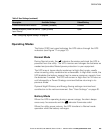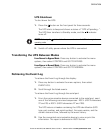OPERATION
Eaton
®
9130 UPS (700–3000 VA) User's Guide S 164201718 Rev 2 www.powerware.com
49
You can prohibit Bypass (”Never”) or always allow Bypass with no
specification checking (”Always”). For “Always on UPS Fault,” transfer
to Bypass is always made on UPS fault; otherwise, operation proceeds
as with the default setting.
Synchronization Window. The UPS tries to synchronize with Bypass when
the Bypass frequency is less than the value set for the “Synchronization
Window” setting. When the Bypass frequency is more than the set
value, the UPS goes to nominal frequency. On Bypass the
synchronization window is ±5 Hz. If synchronization is disabled (”Sync
Disabled”), the UPS will synchronize only when operating on Bypass.
Unsynchronized Transfers. The default allows an unsynchronized transfer
to Bypass. You can configure the setting to not allow such transfers.
This setting can be overruled by the “Qualify Bypass” setting.
Configuring Load Segments
Load segments are sets of receptacles that can be controlled by power
management software or through the display, providing an orderly
shutdown and startup of your equipment. For example, during a power
outage, you can keep key pieces of equipment running while you turn
off other equipment. This feature allows you to save battery power.
Each UPS has two configurable load segments:
S Load Segment 1: Upper outlets and higher rated outlets if available.
S Load Segment 2: Lower outlets
See “Rear Panels” on page 91 for load segments for each UPS model.
To control the load segments with power management software, see
your power management software manual for details (refer to the
Software Suite CD or www.powerware.com for the latest information).
To control the load segments through the display:
1. Press any button to activate the menu options, then select
CONTROL and LOAD SEGMENTS.
2. Set the desired load segment ON or OFF, and ENTER to confirm.
3. Set the other load segment if applicable.


















